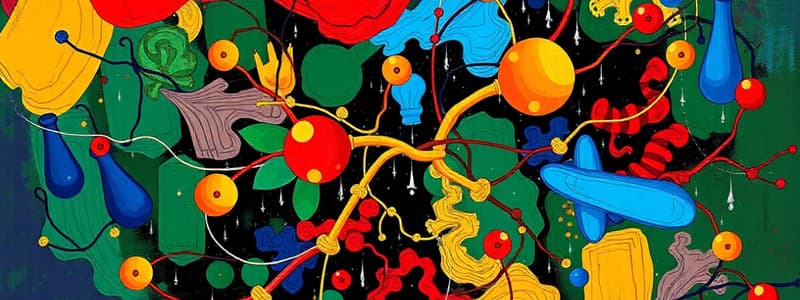Podcast
Questions and Answers
What is pharmacology primarily concerned with?
What is pharmacology primarily concerned with?
- The evaluation of drug therapeutic outcomes
- The study of drug interactions and toxicity
- The legal regulations surrounding drug use
- The nature, actions, and mechanisms of drugs (correct)
What distinguishes a partial agonist from a full agonist?
What distinguishes a partial agonist from a full agonist?
- A partial agonist activates a receptor but to a lesser degree than a full agonist. (correct)
- A partial agonist only binds to receptors without activation.
- A partial agonist has no effect on receptor activity.
- A partial agonist fully activates a receptor while inhibiting it.
Which term refers to the elimination process of a drug from the body?
Which term refers to the elimination process of a drug from the body?
- Elimination (correct)
- Absorption
- Distribution
- Metabolism
Which statement best differentiates between competitive and non-competitive antagonism?
Which statement best differentiates between competitive and non-competitive antagonism?
How does protein binding affect drug distribution and action?
How does protein binding affect drug distribution and action?
Which of the following is an example of a drug-induced disease?
Which of the following is an example of a drug-induced disease?
What is the primary effect of a competitive antagonist?
What is the primary effect of a competitive antagonist?
What categorizes a drug as contraindicated?
What categorizes a drug as contraindicated?
Which type of drugs is known to cause teratogenesis?
Which type of drugs is known to cause teratogenesis?
What characterizes an antagonist compared to an agonist?
What characterizes an antagonist compared to an agonist?
Which of the following best describes a partial agonist?
Which of the following best describes a partial agonist?
How do drug interactions occur?
How do drug interactions occur?
Which of the following is not a type of adverse drug reaction?
Which of the following is not a type of adverse drug reaction?
What is the effect of enzyme induction on drug metabolism?
What is the effect of enzyme induction on drug metabolism?
Which drug is classified as an inhibitor of microsomal oxidation?
Which drug is classified as an inhibitor of microsomal oxidation?
What occurs when microsomal enzymes are inhibited?
What occurs when microsomal enzymes are inhibited?
What is the primary role of the kidneys in drug excretion?
What is the primary role of the kidneys in drug excretion?
Which of the following statements is true regarding microsomal enzymes?
Which of the following statements is true regarding microsomal enzymes?
What is the primary function of a drug in the body?
What is the primary function of a drug in the body?
Which of the following routes of drug administration is classified as enteral?
Which of the following routes of drug administration is classified as enteral?
What is measured by the half-life of a drug?
What is measured by the half-life of a drug?
What does pharmacokinetics specifically study?
What does pharmacokinetics specifically study?
What is the purpose of a loading dose?
What is the purpose of a loading dose?
What characterizes an adverse reaction to a drug?
What characterizes an adverse reaction to a drug?
What is typically measured to determine whether a therapeutic effect has been achieved?
What is typically measured to determine whether a therapeutic effect has been achieved?
Which of the following refers to the study of how drugs affect the body?
Which of the following refers to the study of how drugs affect the body?
What is the primary function of a non-competitive antagonist?
What is the primary function of a non-competitive antagonist?
Which route of exposure involves inhaling a chemical from particulate matter?
Which route of exposure involves inhaling a chemical from particulate matter?
What factor does NOT affect drug absorption?
What factor does NOT affect drug absorption?
Which method of distribution allows molecules to move against a concentration gradient?
Which method of distribution allows molecules to move against a concentration gradient?
What is a key characteristic of passive diffusion?
What is a key characteristic of passive diffusion?
Which characteristic does NOT relate to the characteristics of the body affecting absorption?
Which characteristic does NOT relate to the characteristics of the body affecting absorption?
Which process involves the engulfing of solid substances by cells?
Which process involves the engulfing of solid substances by cells?
Which is NOT a method by which small molecules cross biological lipid membranes?
Which is NOT a method by which small molecules cross biological lipid membranes?
Flashcards are hidden until you start studying
Study Notes
Definitions
- Pharmacology: The science concerned with drugs, their nature, actions, mechanisms, pharmacokinetics, uses, preparations, and administration.
- Pharmacotherapeutics: The appropriate selection and application of drugs for disease prevention and treatment, focusing on therapeutic effects.
- Toxicology: The study of adverse drug effects, including side effects, overdose toxicity, and allergic reactions.
- Pharmacokinetics: The study of how drugs are absorbed, distributed, metabolized, and excreted (ADME) in the body.
- Pharmacodynamics: The study of the effects of drugs on the body and their mechanisms of action.
Agonists, Partial Agonists, and Antagonists
- Agonist: A drug that binds to receptors and mimics the action of the intended biological substance, producing a physiological response.
- Partial Agonist: Binds to receptors but produces a lesser response than a full agonist.
- Antagonist: Binds to receptors, blocking the action of agonists and preventing a physiological response.
Competitive vs Non-Competitive Antagonism
- Competitive Antagonism: Antagonist competes with agonist for the same binding site on the receptor but does not activate it, preventing the agonist effect.
- Non-Competitive Antagonism: Antagonist binds to a different site, inhibiting the receptor's activation regardless of agonist presence.
Drug Processes
- Absorption: The process by which a drug enters the bloodstream, influenced by factors like lipid solubility and ionization.
- Distribution: How the drug spreads through the body, crossing membranes via diffusion, filtration, special transport, and endocytosis.
- Metabolism: The chemical modification of a drug, often involving liver enzymes like cytochrome P-450, affecting drug efficacy and toxicity.
- Excretion: The elimination of drugs through kidneys, liver, skin, or lungs, based on molecular size and charge.
Drug Administration Routes
- Enteral: Oral, sublingual, buccal, and rectal routes.
- Parenteral: Intradermal, subcutaneous, intramuscular, intravenous, intra-arterial, intrathecal, intrapleural, intra-articular, and inhalation routes.
- Topical: Administration via skin, ear, eye, nose, vaginal, and respiratory routes.
Half-Life and Steady State
- Half-Life: Time taken for a drug's concentration to reduce by half; important for understanding dosing and scheduling.
- Steady State: Achieved when drug intake equals elimination, typically occurring after five half-lives.
Factors Affecting Drug Absorption
- Drug-related factors: Lipid/water solubility, molecular size, degree of ionization, dosage forms, and formulation.
- Body-related factors: Surface area, vascularity, pH, GI motility, presence of other substances, and health of the absorptive surface.
Protein Binding and Drug Distribution
- Protein binding affects drug distribution and therapeutic action; highly bound drugs may have altered efficacy.
Cytochrome P-450 Enzymes
- Involved in drug metabolism; inducers increase enzyme activity leading to decreased drug efficacy, while inhibitors decrease activity, increasing toxicity risks.
Active vs Inactive Metabolites
- Active Metabolites: Retain therapeutic activity.
- Inactive Metabolites: No therapeutic effect, often resulting from drug metabolism.
Adverse Drug Reactions
- Include side effects, toxicity, allergic reactions, iatrogenic diseases, and teratogenesis that can cause fetal abnormalities.
- Contraindications exist when a drug should not be prescribed due to potential harm.
- Drug interactions can alter the pharmacological effect, necessitating careful management.
Key Examples
- Inductors: Drugs like phenobarbital can increase enzyme activity in drug metabolism.
- Inhibitors: Metronidazole decreases enzyme activity, leading to increased drug toxicity.
Studying That Suits You
Use AI to generate personalized quizzes and flashcards to suit your learning preferences.



